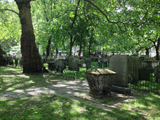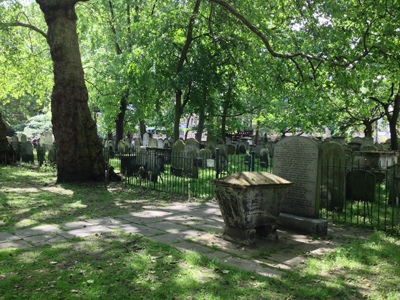Town mouse's London: Bunhill Fields
Just north of the City of London lies Bunhill Fields, an extraordinary site which evokes the complicated history of the city, and provides a resting place for some well-known names


Dame Mary Page died in 1728, the widow of the wealthy merchant and director of the East India Company Sir Gregory Page. We might not think twice about her if it weren't for the details of her last illness, recorded in fascinated detail on the side of her large tomb: ‘In 67 months she was tapped 66 times ... 240 gallons of water drawn without ever repining at her case or ever fearing the operation.'
Brave in the face of suffering, she was also, one can't help feeling, an example to medical science, if not the prurient curiosity of an age which rejoiced in wonders of nature. She is buried in Bunhill Fields, just north of the City of London.
The derivation of Bunhill may be Bone Hill: it has been a burial place for centuries. These days, city workers come and eat their sandwiches in the somewhat lugubrious shade.
There are also, from time to time, literary pilgrims, seeking the graves of three of the greatest and most original figures from the history of English letters: John Bunyan, author of Pilgrim's Progress, Daniel Defoe, who, while not operating as a Whig spy and journalist, wrote Robinson Crusoe, and the poet, artist and visionary, William Blake.

Later admirers put up conspicuous memorials, but their original graves lie somewhere below the forest of headstones that reflect the density with which this burial ground was used: churchyards were not pretty places in the Georgian period. All three writers were Dissenters, or Protestants who did not belong to the Church of England. Bunhill Fields was one of the few recognised burial places available to them.
Dissenters included Presbyterians, Baptists, Methodists, Independents, Congregationalists and Quakers. Like Roman Catholics, they suffered various disadvantages in the seventeenth and eighteenth. They could not hold civil or military office, or take degrees from either of the only two English universities, Oxford and Cambridge. Discrimination pursued them even after death, since they could not be buried in ground consecrated by the Church of England.
Until the development of cemeteries such as Highgate (qv) in the nineteenth century, Anglican churchyards - overcrowded, insanitary and offensive though they became - had something of a monopoly on the rites of death.
Sign up for the Country Life Newsletter
Exquisite houses, the beauty of Nature, and how to get the most from your life, straight to your inbox.
Dissenting congregations were rarely rich enough to buy burial land next to their chapels. The Corporation of London, perhaps because the City was inevitably more cosmopolitan than other areas, was the only civic authority to provide its own solution.
During the Great Plague, which created an urgent need for sites where victims could be buried, it acquired Bunhill Fields. It had probably already been used for burials, when in 1549 the contents of the overflowing charnel house at St Paul's Cathedral were re-interred - hence the supposed original name of Bone Hill. The plague receded before Bunhill Fields was pressed into use; but the place remained available for burials, particularly if not exclusively of Nonconformists.
John Bunyan, the son of a tinker, took to religion after an ungodly youth through the influence of his first wife, who owned two religious books. For twelve years he was imprisoned for ‘sedition' in Bedford Gaol, refusing to secure his own release by suing for pardon. Let free when Charles II suspended the laws against Nonconformists and Roman Catholics, he died while preaching in London in 1688. Born into a dissenting family, Daniel Defoe - born plain Foe - began life as a soldier and merchant, adding the ‘de' to his name as a mark of gentility. Financial disaster led him, in middle age, to start writing, though his literary career was as tempestuous as his commercial one: he was committed to the pillory, and his tile works (which supplied bricks for Greenwich Hospital (qv) among other places) folded. He found work as a government propagandist and spy, reporting on the Jacobites in exile. Robinson Crusoe and A Tour Through the Whole Island of Great Britain were published at the end of his flamboyant career. His burial in recorded in the Bunhill Fields register for 1731 under the name of ‘Mr Dubow, Cripplegate'.
William Blake, a follower of the Swedish scientist, Biblical scholar and mystic Emanuel Swedenborg, devoted his poetry and art to the expression of his moral convictions, often in mystical or visionary form. Half way through his life, Swedenborg believed that he had been given privileged access to the spirit world which man would inhabit after death, filled with its angels and demons.
This parallel universe of the spirit, starkly polarised into good and evil, can be spied both through Blake's early Songs of Innocence and Experience and his later impenetrably symbolic epic poems. Always Blake extolled the primacy of imagination over intellect and convention; he was the Dissenter's Dissenter.
Little of his work appeared as other books of his day, since it combined engraved text with intensely personal, swirling illustrations, which he coloured by hand. The exact whereabouts of his grave at Bunhill Fields, to which his body was committed in 1827, is unknown.
As well as writers, Bunhill Fields contains the graves of pastors, doctors, soldiers, convicts and the representatives of many other callings - among them, some of the descendants of England's most conspicuous Dissenter, Oliver Cromwell.
* Subscribe to Country Life and save
* Follow Country Life magazine on Twitter
* Follow Clive Aslet on Twitter
Country Life is unlike any other magazine: the only glossy weekly on the newsstand and the only magazine that has been guest-edited by HRH The King not once, but twice. It is a celebration of modern rural life and all its diverse joys and pleasures — that was first published in Queen Victoria's Diamond Jubilee year. Our eclectic mixture of witty and informative content — from the most up-to-date property news and commentary and a coveted glimpse inside some of the UK's best houses and gardens, to gardening, the arts and interior design, written by experts in their field — still cannot be found in print or online, anywhere else.
-
 Vertigo at Victoria Falls, a sunset surrounded by lions and swimming in the Nile: A journey from Cape Town to Cairo
Vertigo at Victoria Falls, a sunset surrounded by lions and swimming in the Nile: A journey from Cape Town to CairoWhy do we travel and who inspires us to do so? Chris Wallace went in search of answers on his own epic journey the length of Africa.
By Christopher Wallace
-
 A gorgeous Scottish cottage with contemporary interiors on the bonny banks of the River Tay
A gorgeous Scottish cottage with contemporary interiors on the bonny banks of the River TayCarnliath on the edge of Strathtay is a delightful family home set in sensational scenery.
By James Fisher